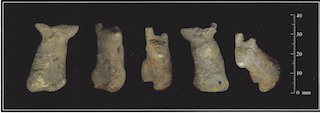Oeškeso (pronounced ōsh-kiss), a Cheyenne word for dog, inspired the name for the archaeological site at which the Oeškeso zoomorphic or animal effigy was recovered. The figure is characterized as a canine, although it could represent another animal prized by prehistoric plains inhabitants such as a deer, antelope or rabbit. It measures one and one-half inch in height, and is made of reddish brown fired ceramic. It has not been determined whether the Oeškeso effigy was a ceremonial object perhaps related to hunting, a child’s toy, or was intended for some other purpose.
Different regions of Colorado have shaped different stories of prehistoric people. Effigy figures are more frequently found in the Southwest corner of our state. The Oeškeso zoomorphic effigy figure, however, is unique in Colorado plains archaeology and gives us a fresh view of early life in this region.
The Oeškeso effigy provides unique insight into prehistoric life on Colorado’s plains. Colorado’s early plains residents left little material evidence of their nomadic lifeways for archaeologists to study. Thus, the majority of information about native plains dwellers comes from photographic and written documentation by European explorers and settlers, as well as hide paintings and legerbook art created by plains tribes in the late 19th century (see the 2014 nominee Cheyenne Dog Soldier Legerbook). The Oeškeso effigy figure demonstrates an aspect of life on Colorado’s plains one thousand years earlier in time.
Douglas County History
100 S. Wilcox
Castle Rock, CO 80104
United States

